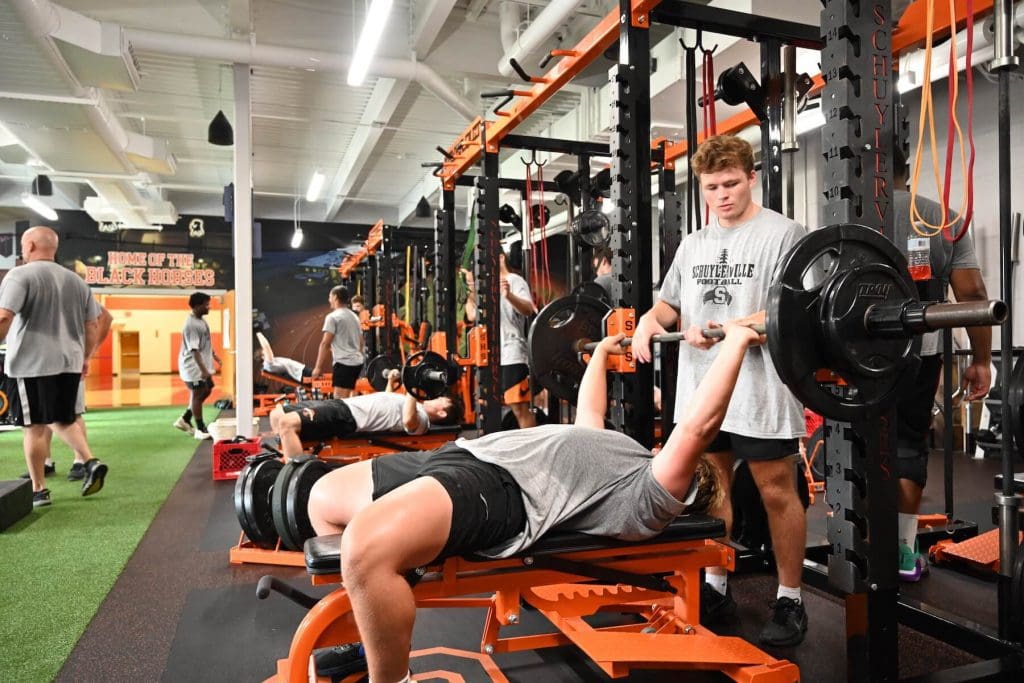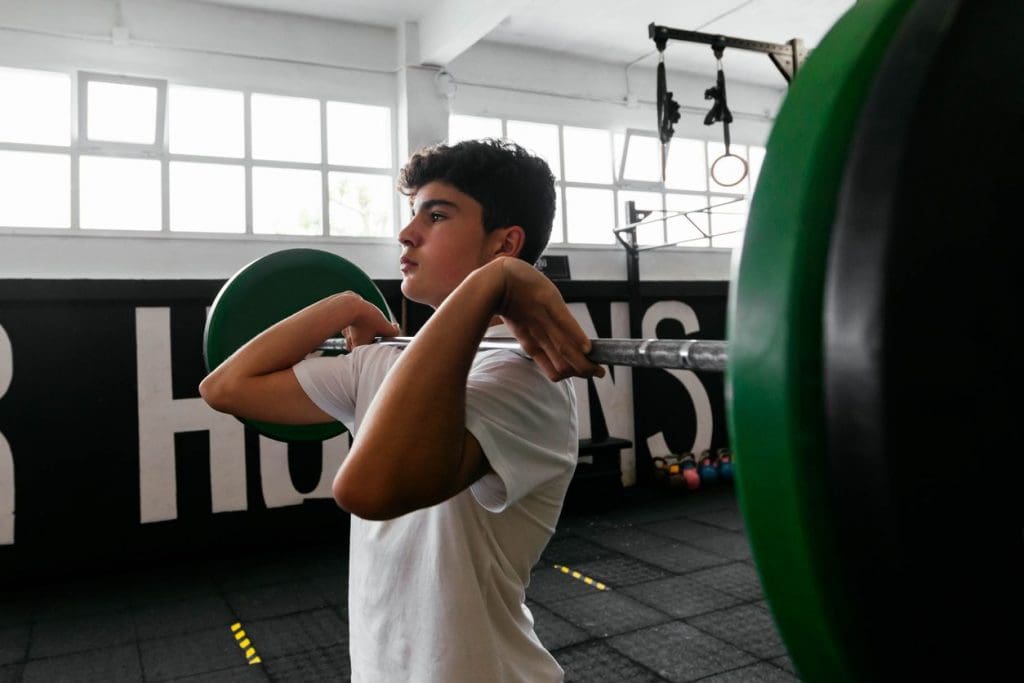There are endless benefits for athletes who participate in a proper strength training program. While many athletes, coaches, and teams typically look for stronger muscles and improved athletic performance in the weight room, injury prevention is one of the most significant benefits of strength training. We explore the what, why, and how of strength training for injury prevention and how it relates to the high school weight room.
Strength Training For Injury Prevention In Action
High school physical education and athletic departments all across the country are embracing the power of strength training for injury prevention. Before we dive into the science of strength training for injury prevention, let’s see what coaches, athletic trainers, and athletic directors are saying about the role of the weight room in overall health of high school athletes,
At Plainfield South High School in Illinois, Athletic Trainer and PE department chair Brian Beck says that the push for weight training classes was driven by the importance of injury prevention,
“Getting students into the weight room promotes injury prevention and keeping our athletes healthy. So many injuries are a result of a lack of strength. The weight training classes are helping the betterment of our athletes in so many ways.”
At Van Wert High School in Ohio, Head Football Coach Keith Recker says that the weight room has played a big role in their road to a state championship,
“We have seen a dramatic decrease in the number of injuries, and that is a credit to using professionally designed programs. Having a long-term plan in the weight room has allowed more athletes to reap the benefits on and off the field.”
And at Schuylerville High School in New York, Athletic Director and Head Football Coach John Bowen explains the importance of injury prevention plays in the high demands of a season,
“Teams are only successful if they can stay healthy through a long-season. We put a lot of work in our training sessions on being physically prepared, but also focusing on our overall health.”
Strength Training For Injury Prevention Video Podcast
Check out a the full conversation with Doug Curtin and Sam Breslin. This video podcast breaks down injury prevention.
Types of Injury
Before exploring the benefits of strength training for injury prevention, it is crucial to understand the different types of injury athletes can experience.
In the realm of injuries, two main categories are commonly used to classify them based on their duration and onset: acute injuries and chronic injuries. Understanding the difference between these two types of injuries is crucial for effective prevention, management, and treatment.
Acute Injuries: These injuries typically have a sudden onset and occur due to a specific incident or trauma. For example, an acute injury could be a broken leg or sprained ankle that results from contact or extreme positioning. To a degree, acute injuries are unavoidable, but not entirely—more on how strength training for injury prevention plays a role in acute injuries.
Chronic Injuries: Otherwise known as overuse injuries, these typically result from repetitive stress or prolonged exposure to specific movements or activities. For example, a runner’s knee or tennis elbow are overuse injuries often associated with preventable factors such as poor biomechanics, inadequate training, or pre-existing conditions. These common injuries can be avoided through strength training for injury prevention.

Common Causes of Injury
Many factors go into injury, but some common causes of soft-tissue injury can help further illuminate the importance of strength training for injury prevention. Some of the factors are listed below:
Previous injury – The strongest predictor of injury is history of previous muscle injury. Scar tissue is weaker and less elastic than the surrounding tissue, making it the weakest link in the musculotendinous unit and thus most susceptible to injury. This requires actual rehabilitation and return-to-play plans that should be discussed with sports medicine professionals.
Imbalance – Other things that contribute to muscle strains include poor stability and muscle imbalances. Strength deficiencies and overcompensation are often the beginning of the injury process. The human body will compensate whenever there’s an imbalance, and the weakest link in the chain will break first.
Fatigue – Fatigue, which affects both the muscles and the central nervous system, also plays a vital role in strain injury. Continued loading of a fatiguing muscle will result in eventual mechanical failure, just like any other material. With fatigue, the elasticity of the muscle and tendon decreases, reducing the amount of strain energy they can absorb.
Flexibility – Finally, it stands to reason that inflexibility would increase the risk of injury, although the evidence is mixed and likely task-specific.
Other – Other factors include previous immobilization, weakness, cold temperatures, and unexpected cool-down. All of these things tend to reduce a muscle’s contractile capability and, consequently, its ability to absorb strain energy.
Benefits of Strength Training For Injury Prevention
Strength training has a wide variety of benefits for injury prevention. But what happens in our body when we take part in a weight training program? Below, we break down some benefits to the effect on bone, connective tissue, and muscle.

Effect on Bone
Because bone is a living tissue, it can remodel and adapt to the physical stresses imposed on it. Physically active individuals have been shown to have greater bone mineral density than sedentary individuals.
In general, physically active persons are at a reduced risk for osteoporosis, fracture, or other ailments related to bone deterioration. Although bone will respond to many types of training programs, especially those with high strain, such as jumping or running, resistance training provides the greatest osteogenic (increase in bone mineral density) effect.
Resistance training is beneficial for increasing bone strength, and muscular strength also appears to be positively related to bone mineral content and bone strength. As lower-body strength levels increase, the incidence of stress fracture is reduced. Thus, muscular strength improves bone strength as well.
Free Download!
The Ultimate Guide to High School S&C
Learn how to navigate the many logistical challenges that face high school coaches, and get insights into how to program effective workouts.

Effect on Connective Tissue
Connective tissue provides the support or framework of the body. It consists of cells and fibers embedded in a gel-like material containing tissue fluids and various metabolites. The primary fiber of connective tissue is collagen.
Although, to date, there has been little research conducted on the direct effect of resistance training on connective tissue adaptations, what studies there have been reported increases in both the size and strength of ligaments and tendons. Increases in the size of connective tissues are thought to result from an increase in the collagen content within the connective tissue sheaths.
Although collagen content increases with training, comparisons between untrained individuals and bodybuilders suggest that the increase in collagen content is proportional to the increase in muscle. Bodybuilders seem to have greater absolute collagen content, but relative values are similar to untrained controls. Thus, increases in muscle mass are likely met by increases in the size and strength of the connective tissue.

Effect on Muscle
Decreases in muscle mass (sarcopenia) and subsequent reductions in muscle strength as one ages not only result in a loss of functional ability but also increase the risk of falls and fractures. Resistance training programs for an aging population have the same benefits for increase in strength and muscle size as for the younger and more active population.
As functional ability is maintained or improved, the risk of injury is significantly reduced. Resistance training also has an important role in reducing the risk for musculoskeletal injuries related to muscle imbalance, expressed as either an agonist-to-antagonist ratio (i.e., knee flexors/ knee extensors) or a bilateral comparison (i.e., right and left knee flexors).
Correction of the existing imbalance through a resistance training program is important to reducing the individual’s risk for muscle injury.
What is Strength Training For Injury Prevention?
When people hear about the benefits of strength training for injury prevention, they immediately want to know what constitutes injury prevention exercises. Often, there is an assumption that injury prevention exercises must be a dedicated part of a training program. For example, coaches look to add dedicated time to use foam rollers or resistance bands to do “pre-hab.” And while these can be helpful, there are many more places where injury prevention is happening inside the weight room.
Strength training for injury prevention is a comprehensive approach to resistance training and athletic performance programs. A well-rounded strength and conditioning program can and should develop strength, power, capacity, mobility, stability, flexibility. Read more here on strength and conditioning programming.
From a long-term standpoint, injury reduction strategies parallel many of the same basic tenets of general performance enhancement. These strategies include:
Improved stability and task-specific flexibility.
Conditioning to delay the onset of fatigue.
Reduction in muscle imbalances (agonist-antagonist as well as side to side).
Progressive overload using hypertrophy, (eccentric) strength, and power protocols for increased tensile strength of muscles and tendons.
Proper periodization of all of the aforementioned training variables.
In short, a well-rounded strength and conditioning program that athletes consistently participate in will help to decrease injury risk. Not all sports injuries are preventable, but a well-rounded strength training program can aid in teams’ and athletic departments’ long-term injury prevention goals.

Study on Strength Training For Injury Prevention
A study was undertaken of injury rate and time lost to rehabilitation in a cohort of high-school athletes and determined that all athletes utilizing resistance training as part of their exercise program suffered an injury rate of 26.2% compared to 72.4% of those that did not.
In addition, the authors found that the rehabilitation ratio (time lost to rehabilitation due to injury per number of athletes performing in the studied group) was 2.02 days in those who utilized RT compared to 4.82 days for those not engaging in resistance training.
As such, that study demonstrated fewer and less severe injuries in individuals engaging in weight training. In addition, those individuals engaging in resistance training were able to return to sport much sooner.
Key Takeaways on Strength Training For Injury Prevention
High school athletes put so much time and effort into the sports they love. The last thing we want to see is athletes sidelined by injuries that otherwise could have been prevented.
While the the weight room has always been seen as a place to improve physical performance, one of greatest benefit of strength training is for injury prevention. Every athlete, regardless of sport, can improve overall health inside the weight room and reap the benefits of a strength and conditioning program.










